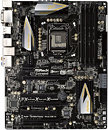- Joined
- Oct 9, 2007
- Messages
- 47,619 (7.44/day)
- Location
- Dublin, Ireland
| System Name | RBMK-1000 |
|---|---|
| Processor | AMD Ryzen 7 5700G |
| Motherboard | Gigabyte B550 AORUS Elite V2 |
| Cooling | DeepCool Gammax L240 V2 |
| Memory | 2x 16GB DDR4-3200 |
| Video Card(s) | Galax RTX 4070 Ti EX |
| Storage | Samsung 990 1TB |
| Display(s) | BenQ 1440p 60 Hz 27-inch |
| Case | Corsair Carbide 100R |
| Audio Device(s) | ASUS SupremeFX S1220A |
| Power Supply | Cooler Master MWE Gold 650W |
| Mouse | ASUS ROG Strix Impact |
| Keyboard | Gamdias Hermes E2 |
| Software | Windows 11 Pro |
Motherboards based on the Intel Z77 Express chipset are on course for an April 8 launch, even if you won't find compatible 3rd Generation Core processors on shelves, on that day. Here is the first picture of a finished and good-to-go ASRock Z77 Extreme6 motherboard, which will be the company's flagship board based on the Z77 chipset, in its main product line.
The Z77 Extreme6 comes with the same black and gold styling found on the company's X79 motherboard lineup. The LGA1155 CPU socket is powered by a 12-phase DigiPower VRM. It is wired to four DDR3 DIMM slots, supporting dual-channel DDR3 memory speeds with over DDR3-2800 MHz speeds by overclocking. Expansion slots include two PCI-Express 3.0 x16 (x8/x8 when both populated), wired to the CPU; one PCI-Express 2.0 x16 (electrical x4), wired to the PCH; a PCI-Express 2.0 x1; a mini-PCIe 2.0 x1 (for wireless network cards, etc.); and two legacy PCI slots (pray why?).


SATA connectivity on the ASRock Z77 Extreme6 includes four SATA 6 Gb/s (two from the PCH, two from a third-party controller), four SATA 3 Gb/s, and one eSATA 6 Gb/s. USB 3.0 connectivity includes four ports on the rear panel, and two via front-panel header. Display connectivity includes one each of DVI, D-Sub, HDMI, and DisplayPort. Other connectivity includes 8+2 channel HD audio (Realtek ALC898), FireWire, and one gigabit Ethernet (Broadcom BCM57781).
The Z77 Extreme6 is backed by numerous features, starting with support for NVIDIA SLI and AMD CrossFire, LucidLogix VirtuMVP, THX TruStudio Pro, and Intel features introduced with the platform such as RapidStart and SmartConnect. Its UEFI firmware setup program also has a limited-functionality OS that just about gets you on the internet, it also has what's known as System Browser, which we guess is a filesystem browser (could be good to backup/steal files).
View at TechPowerUp Main Site
The Z77 Extreme6 comes with the same black and gold styling found on the company's X79 motherboard lineup. The LGA1155 CPU socket is powered by a 12-phase DigiPower VRM. It is wired to four DDR3 DIMM slots, supporting dual-channel DDR3 memory speeds with over DDR3-2800 MHz speeds by overclocking. Expansion slots include two PCI-Express 3.0 x16 (x8/x8 when both populated), wired to the CPU; one PCI-Express 2.0 x16 (electrical x4), wired to the PCH; a PCI-Express 2.0 x1; a mini-PCIe 2.0 x1 (for wireless network cards, etc.); and two legacy PCI slots (pray why?).


SATA connectivity on the ASRock Z77 Extreme6 includes four SATA 6 Gb/s (two from the PCH, two from a third-party controller), four SATA 3 Gb/s, and one eSATA 6 Gb/s. USB 3.0 connectivity includes four ports on the rear panel, and two via front-panel header. Display connectivity includes one each of DVI, D-Sub, HDMI, and DisplayPort. Other connectivity includes 8+2 channel HD audio (Realtek ALC898), FireWire, and one gigabit Ethernet (Broadcom BCM57781).
The Z77 Extreme6 is backed by numerous features, starting with support for NVIDIA SLI and AMD CrossFire, LucidLogix VirtuMVP, THX TruStudio Pro, and Intel features introduced with the platform such as RapidStart and SmartConnect. Its UEFI firmware setup program also has a limited-functionality OS that just about gets you on the internet, it also has what's known as System Browser, which we guess is a filesystem browser (could be good to backup/steal files).
View at TechPowerUp Main Site




